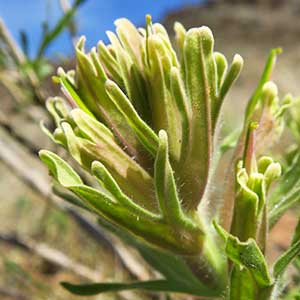Castilleja xanthotricha
Castilleja hololeuca
John Day or yellow-hairy paintbrush, John Day paintbrush, yellow hair paintbrush, yellow-hair Indian paintbrush
Channel Islands paintbrush, island paintbrush, island white-felted paintbrush, white-felted paintbrush
few to several, ± decumbent to erect or ascending, unbranched, sometimes with short, leafy axillary shoots, hairs erect to spreading, long, soft, eglandular, mixed with short stipitate-glandular ones.
many, erect to spreading, much-branched with many short axillary shoots, proximal stems reaching 1+ cm wide, white-felted, hairs dense, spreading to ± appressed, intertwined, long, soft, slightly branched, obscuring surface.
green, linear, lanceolate to broadly lanceolate, oblong, or cuneate, 0.8–5 cm, not fleshy, margins plane to wavy, involute, 0–5-lobed, apex acute, sometimes rounded;
lobes spreading, linear, arising below mid length, nearly as broad as center lobe, apex acute.
ash gray, leaves of previous year persisting on proximal stem, linear, older leaves sometimes broadly linear, 1–5 cm, not fleshy, margins plane, involute, 0-lobed, apex obtuse;
lobes ascending, linear-lanceolate, apex obtuse to rounded, sometimes acute.
3–14 × 1.5–4.5 cm;
bracts proximally greenish, rarely dull reddish purple, distally white to cream, rarely pale yellow or dull, pale pink (sharply differentiated from proximal coloration), lanceolate or oblong to narrowly ovate, (3–)5–7-lobed;
lobes ascending, linear to obovate, ± broadened distally, medium, long, proximal lobes arising below mid length, central lobe apex broadly rounded to truncate, others acute to rounded.
3–16 × 2–4 cm;
bracts pale gray-green throughout, or proximally pale gray-green, distally red or yellow, proximal linear, distal broader, often oblanceolate to obovate, (0–)3-lobed;
lobes spreading, linear to oblong, short to long, arising below mid length, apex rounded to truncate or acute.
curved, 17–23 mm;
tube 15–19 mm;
beak exserted, adaxially green, 5–8(–9) mm, puberulent, stipitate-glandular;
abaxial lip deep purple (color sometimes visible through calyx), green, pinkish, or pale yellow, ± prominent, slightly inflated, usually hidden in calyx, sometimes right at top of calyx, 2 mm, ca. 50% as long as beak;
teeth ascending, whitish, yellowish, pink, or green, 1–1.5 mm.
slightly curved in proximal 1/3, 14–26(–31) mm;
tube 9–17 mm;
abaxial lip not exserted, beak exserted;
beak adaxially green to yellowish, 11–14 mm;
abaxial lip ascending, deep green, reduced, 2–3 mm, less than 33% as long as beak;
teeth reduced to apiculations, deep green, 1–1.5 mm.
colored as bracts, 15–26 mm;
abaxial and adaxial clefts 3.5–7 mm, 25–50% of calyx length, deeper than laterals, lateral 2–5 mm, 12–25% of calyx length;
lobes linear, oblong, or narrowly triangular, center lobe apex usually rounded, lobes acute to rounded.
colored as bracts, with conspicuous whitish veins, 14–18(–20) mm;
abaxial and adaxial clefts 5–12 mm, 30–67% of calyx length, deeper than laterals, lateral 0 mm or nearly so, ca. 0% of calyx length;
lobes linear-lanceolate, apex rounded, truncate, or emarginate.
= 48.
Castilleja xanthotricha
Castilleja hololeuca
Castilleja xanthotricha is endemic to moderate elevations in the sagebrush hills of the John Day River drainage in north-central Oregon. N. H. Holmgren (1971) hypothesized that this tetraploid species is of allopolyploid hybrid origin between C. glandulifera and C. oresbia.
(Discussion copyrighted by Flora of North America; reprinted with permission.)
Castilleja hololeuca is endemic to the four major islands of the northern Channel Islands. It is similar to C. lanata, a mostly Mexican species that reaches Arizona, New Mexico, and southwest Texas. However, C. hololeuca appears to be more closely related to C. foliolosa, a species of the California mainland. These three species, and C. galehintoniae G. L. Nesom of Nuevo León, all share a distinctive, thick indument of pale, matted, and often branched hairs on the stems and leaves. Large individuals of C. hololeuca form thick, woody trunks. On Anacapa Island, closest to the mainland, red-flowered forms of C. hololeuca predominate. On Santa Cruz Island, to the west, both red- and yellow-bracted forms are fairly common, usually in separate populations. Further offshore, on San Miguel and Santa Rosa islands, most plants are yellow to, occasionally, peach in coloration. Reports of this species from Santa Barbara and Santa Catalina Islands are referable to other species, mostly C. foliolosa. Populations of C. hololeuca historically declined from grazing by introduced game and livestock species. The plants are recovering well, following removal of the grazing animals, and are now common in many areas, especially on San Miguel Island.
(Discussion copyrighted by Flora of North America; reprinted with permission.)


